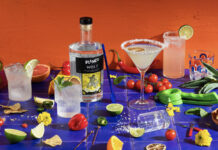With his angular, boyish face perched just below a shock of bright blond hair bleached even lighter by hours of sunlight, Ted Huber looks more like he should be carving custom surfboards and driving a Woody in Santa Barbara than tending to
the endless details of running a “family orchard and winery” that attracts over 600,000 visitors each year. And now he’s added a new twist: Starlight Distillery. Four years ago, Huber obtained the first (and only) artisan distilling license granted to date in Indiana, and Starlight’s first 1,200-bottle release of brandy emerged in 2004 to critical acclaim.
DISTILLER: Tell us about Starlight Distillery. How would you categorize it?
HUBER: We’re a small batch pot still, not a large continuous still. We’re looking at concentration of flavor, not cranking out alcohol. We’re looking for the maximum of quality flavors in our distillate. This includes our choice of varieties, how and when we pick our fruit, the fermentations we use; they’re all chosen to maximize flavor.
DISTILLER: What do you do in your operation to maximize flavor, both before and during distillation?
HUBER: We are totally integrated from ground up and use only grapes, fruits and berries grown here. That way, we control the variety, when to harvest, and the blend of different fruits to achieve the taste we’re looking for. A critical factor is using the proper fermentations. Being a winery since the 1970s, fermenting grapes in many styles and berries and other fruits, we have become skilled at understanding fermentations. We know the chemistry; we pick the yeast and temperatures for best the best result. There’s no formula; it depends entirely on conditions. One blackberry crop we might ferment one way, but then do it a totally different way next year because there’s a difference in the acidity of the berries.
We like to get our fermentations quickly off to good start. We pick the right yeast and temperature for each particular fruit. It’s not like lag fermentation that starts slowly at first. We process the fruit immediately. As soon as the fruit comes in, we start fermentation, even if it’s Sunday morning. We do not want the fruit sitting around—the first five-to- six days are the most critical.
DISTILLER: Fermentation, then distillation. What’s special about your approach?
HUBER: The still is critical, of course, and the temperatures we run it at. You must be very delicate, or you can easily end up scorching the flavor or losing flavor in the distilling process, which can really affect the taste and smell of the final product. We use a four-plate, 80-gallon capacity Christian Carl pot still. We have a clean-in-place system, and our other distiller, Jason Heiligenberg, is a real stickler for making sure the pot and refluxes are cleaned often. We also clean between different varieties of fruits, so there are no crossover flavors. We’ve found that to be very important, so we also do a fresh water bath between each batch we do. A clean still gives clean, fruit forward flavors. Once the still is clean, we run slow, single batch distillations to maximize the varietal quality. We manually run the first batch while we watch for the head, heart and tail cuts. So the first run is done entirely by taste, then for the second run we hook up the mechanical side of it and the still will run itself after that.
The key to making a quality eau-de-vie or brandy is slow, steady distillation for all fruit products. This steady distillation process helps us monitor temperature gradients so that we prevent the burning of flavors. The brandy comes off our still at 170 proof (85% alcohol). Obtaining maximum fruit flavor derives from our basic winemaking practices.
DISTILLER: Tell us about the maturation process. What kinds of barrels do you use?
HUBER: We age in French, American, and Hungarian Oak depending upon the manufacturer. The barrel prices range anywhere from $400 – $700. But I can’t recommend one barrel over another because the choice depends so strongly on the winemaker’s individual style.
The maturation process varies. Federal law clearly states that in order to be labeled as a brandy, it must be aged for no less than two years. Starlight has not released anything aged less than three years.
DISTILLER: What drew you to distilling?
HUBER: Back in mid ‘90s, we began seeing little pot stills at a lot of wine trade shows. I love equipment; a new piece of equipment just draws my eye to it. At first, I spent time with the manufacturers, going to dinner with them, and talking with folks who were already in the distilling business. Over a five-year period I did a lot of research and reading on the subject, and then Kris Berglund started his distilling program at Michigan State University where both Jason and I have taken his classes.
We have also been through distilleries in northern California, Michigan, and the Finger Lakes region of New York. This has helped us get a handle on what products to offer and what works for us. One great thing is that it’s still a small industry; people are fairly open to tell you what’s gone right, what’s gone wrong with things they’ve tried. There’s a lot of art to it. And it’s not like people are giving away secrets—we couldn’t duplicate their products anyway!
DISTILLER: What’s different about the distilling business now compared to when you first started exploring it five years ago?
HUBER: Now, a lot of products I taste from the new companies are very high quality products, and they’re starting to attract a consumer that is very interested in handcrafted products at a high quality. It’s the same for rum, vodkas, and whiskeys. We’re seeing a lot of high quality products out there; it’s a lot like the European tradition, where smaller, high- end products develop very loyal followings.
DISTILLER: What will be different about the craft of distilling in 10–20 years?
HUBER: I see more people getting the experience of visiting a distillery, a lot like people do today with the microbreweries. I think that’s the future—where visitors can see the batch, taste the products, meet the distillers, and we can begin to develop a loyal fan base like wineries and microbreweries did. We’re starting to see it in Michigan. Lots of little artisan distilleries there. When people from there come to Indiana and see that we have a distillery, they tell us about their favorites and talk about tastings and touring at different distilleries. Some distillers will still want to do wholesale only, but I see a lot of opportunity for people in promoting retail sales and tours.
DISTILLER: How important is packaging to your success?
HUBER: At Starlight Distillery we work hard to design the package to fit the qualities of the product, and to market the product appropriately. For example, our brandy is a high-end, high-dollar prestigious product that needed unique packaging and a special release process to match these qualities. Right now, we’re putting the finishing touches on our grappa bottle, tall and tapered with Grappa in large vertical letters screened onto one panel; very nice. We wanted to release it later this winter, but it will probably be next spring.
The products that we are aging now include the grappa, of course (there was only one that we felt was good enough to package), our pear brandy, apple brandy and peach, raspberry and blueberry eaux-de-vie. The apple brandy will come out in 2006, and the pear brandy is due for release in 2007. We have not yet determined when the eau-de-vie varieties will be ready for release.
DISTILLER: What do you consider your flagship products at Starlight Distillery?
HUBER: Our flagship distillates are Blueberry Port and Raspberry Infusion — these two have won numerous international awards. Eighty percent of all of our products are being sold at less than 24 percent alcohol, which accounts for their popularity. Our brandy, which is a premium brand, is also a signature product for us.
DISTILLER: The recent Supreme Court ruling required states to “level the playing field” regarding interstate shipments of wine and spirits. Indiana chose to make all direct shipments to customers illegal. Will Indiana’s ruling have a significant impact on Huber Winery and Starlight Distillery business?
HUBER: Yes, very much so. The Indiana wine industry is working aggressively to get this settled within our state so that shipping to customers can resume.
DISTILLER: Given all the difficulties in starting up and running a distilling business, what has kept you motivated to make Starlight Distillery unique?
HUBER: I think I’m most passionate about distilling because it allows me to expand my winemaking knowledge and to engage my artistic nature. I’m also passionate about distilling because it allows me, my wife Dana, and my partner Greg, who is also my cousin, to continue the important heritage of our family.









